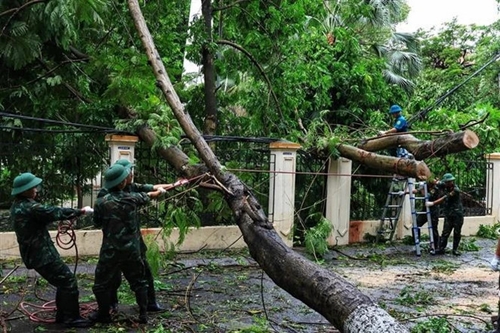The conference, which was connected to 26 Northern provinces and centrally-run cities, aimed to evaluated the direction of response to the typhoon and damage, and deploy measures to overcome its consequences.
    |
 |
|
Military personnel help with the clearance of fallen trees. |
According to the Ministry of Natural Resources and Environment, Yagi is the strongest typhoon to hit the East Sea (aka South China Sea) in the past three decades. On September 7 afternoon, the typhoon made landfall in Quang Ninh province and Hai Phong city. Despite weakening into a tropical depression on the following day, it continued to wreak havoc, with heavy rains and winds lashing the Northern region.
The Ministry of Agriculture and Rural Development confirmed five fatalities in Quang Ninh, Hai Phong, and Hai Duong, and injured 186 people in Quang Ninh, Hai Phong, Hai Duong, and Hanoi by 7:00a.m. on September 8. Especially, a landslide in Hoa Binh province claimed four lives and injured another in a family. Power outage and communication disruption have left many areas isolated.
The typhoon, the third to hit the country this year, left huge damages in terms of infrastructure, with thousands of 3,279 houses damaged, 401 power utility poles pulled down, and numerous shops, offices, and schools suffering roof damage. Thousands of trees were uprooted while many billboards were broken, creating hazardous conditions on the streets.
The agricultural sector has also borne the brunt of the typhoon, with over 121,500 ha of crops inundated and more than 1,000 aquaculture cages and rafts destroyed or swept away, mostly in Quang Ninh.
The National Center for Hydro-meteorological Forecasting has issued warning of continued heavy rain in the Northern region on September 8-9. With 24-hour rainfall potentially exceeding 200mm in some areas, the risk of flash floods and landslides remains high.
Source: VNA